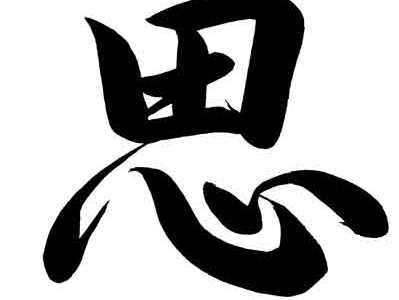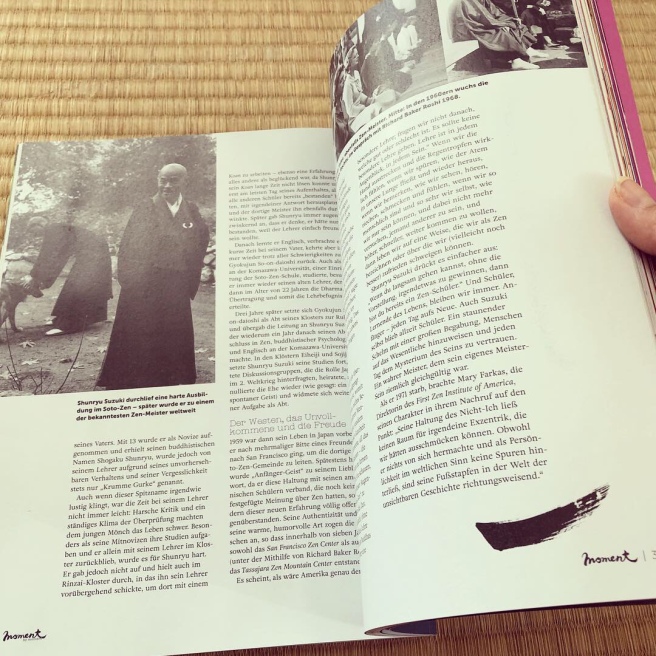KONNICHIWA,
Are you ready to go through some deep thoughts in one of your autumn evenings?!
I’ve been thinking about HISHIRYO: NON-THINKING for a quite while now, especially in conjunction with the essence of Do-Arts ( SHODO, KYUDO, JUDO, SADO, KADO, KARATEDO, AIKIDO….)
I guess when one practises the Do-Art ( in my case I did Kendo, have been practising Shodo for more than 35 years and Sado: Tea ceremony for 8 years) regularly and constantly if not everyday, one gets the nucleus of HISHIRYO. I do not particularly sit and meditate every day for 30 min, not at all – but instead I do meditation while I do calligraphy. “Calligraphy-SHODO” is for me an automatic switch to become meditative, this is my meditation. I do not have to make any effort or try hard to get to that point anymore. Sure, I am not doing Zazen or sitting, but the flow of the mindfulness-process, the flow of movement which I practise every day, creates such a natural comfortable silence. I become one with the moment – and feel through the brush, the ink and then see how the oneness appears on the paper. That is for me the closest understanding of HISHIRYO now.
And I often remember how my calligraphy teacher and my tea master teacher always said ;
” stop thinking, trust your hands and body – don’t worry
they know what to do ”
HISHIRYO 非思量 is found in one of the most essential works called SHOBOGENZO/Fukanzazengi 正法眼蔵/普勧坐禅儀 ( 1231-1253) from the Zen master Dogen-Zenji ( 1200-1253 )
I found this very interesting article which describes HISHIRYO quite clear. See below.
*For German speaking readers, there is an interesting article too by Gert Scobel in the new moment by moment magazine; under the theme” Meditation” ( www.moment-by-moment.de)
*Credit and Copyright:
Originally written in Japanese by Rev. Tairyu Tsunoda ( Komazawa University ), Translated by Rev. Issho Fujita
Assisted by Rev. Tonen O’Connor and Rev. Zuiko Redding
*Links and Materials from Soto Zen Buddhism: sotozen.net

Hishiryo (non-thinking)
Etymology of Hishiryo
Hishiryo (非思量) literally means “non-thinking.”
Shiryo (思量) means “thinking” and hi (非) is a prefix of negation and opposition.
So hishiryo amounts to “unthank” or “not the matter of thinking.” This word hishiryo appears in Dogen Zenji’s Fukanzazengi (although not in his signed manuscript), Shobogenzo Zazengi, Shobogenzo Zazenshin and in Keizan Zenji’s Zazen Yojinki. It is one of the most important words used to describe zazen. Hishiryo in these writings comes from a dialogue between Yakusan Igen (745~828) and an unnamed monk, which is described in Keitoku
Dentoroku and other Zen texts.
Great master, Yakusan Kodo was sitting zazen. A monk asked him, “In steadfast sitting, what are you thinking?” Yakusan said, “Thinking of not-thinking.” A monk said, “How are you thinking of not-thinking?” Yakusan replied, “Non-thinking (hishiryo).”
In answering “hishiryo,” Yakusan is pointing out a realm beyond discriminative thinking, a realm of being one with not-thinking, which is the original person, or true person. This dialogue is meant to signify that zazen is the practice of being one with the original person, the person we originally are.
In the Zen tradition the word hishiryo is also found in a much earlier text, the Third Sosan’s Shinjinmei.
The empty enlightenment illuminates itself.
There is no need for the slightest mental effort.
It is a realm of non-thinking,
A realm beyond the apprehension of reasoning and emotions.
In this context, hishiryo is explained as a realm beyond the ability of reasoning and emotions to grasp. Later, this word was used in this more developed way. For example, in Unmon Koroku (Unmon’s Extensive Record) we find this dialogue below.
A monk asked, “What is a realm of non-thinking like?” Unmon said, “Beyond apprehension of reasoning and emotions.”
The meaning of hishiryo in Soto Zen
In both Fukanzazengi and Zazen Yojinki, hishiryo was introduced right after an instruction on zazen posture that uses the expression, “steadfast sitting.” Therefore, hishiryo can be understood as
a description of the state the mind should be in once zazen posture has been properly established. As for this state of mind in zazen, we find these instructions:
*In Fukan Zazengi
Do not think “good” or “bad.” Do not judge true or false. Give up the operation of mind, intellect, and consciousness; stop measuring with thoughts, ideas, and views. Have no designs on becoming a Buddha. How could it be limited to sitting or lying down?
*In Zazen Yojinki
Drop mind, intellect and consciousness, leave thoughts, ideas, and views alone. Have no designs on becoming a Buddha. Do not judge true or false.
If you want to cease your confusion, you must cease involvement in thoughts of good or bad.Stop getting caught up in unnecessary affairs. A mind “unoccupied” together with a body “free of activity” is the essential point to remember.
I think the key to understanding the meaning of hishiryo is found in these teachings.
It is said that when we practice zazen we stop all kinds of thinking, such as true or false, right or wrong and let go of all thoughts and calculations. With this attitude, we just sit. This is the instruction given by Dogen Zenji and Keizan Zenji. And that is what hishiryo is all about.
Hishiryo is not a state of no-thoughts
To stop “the operation of mind, intellect, and consciousness” and to stop “measuring with thoughts, ideas, and views” does not mean to totally stop all mental activities. To stop “operation” and “measuring” means stopping arbitrary thought and calculations, rather than maintaining a state of having no thoughts during zazen. The idea of having no thoughts is itself an arbitrary thought. It is not that a special state of mind results from regulating the mind through zazen. Rather than having a special state of mind, zazen is not to have a special state of mind.
For example, we find this passage in Shobogenzo Zazenshin:
A monk asked, “How are you thinking of not-thinking?” Indeed, though the notion of not-thinking may be old, here it is the question, how do you think of it? Could there be no thinking in sitting fixedly? … When we think of not-thinking, we always use non-thinking.
When we sit in zazen, it is not that we have no thoughts but we think of “not-thinking.” It is called “how do you think of it” and “non-thinking.”
In zazen we just sit by regulating the body (posture) and regulating the breath. As for the posture, we aim at sitting in the way that is described in Fukanzazengi and Zazen Yojinki. This posture naturally regulates the breath. Then, we just let the breath happen as is described in Zazen Yojinki; breath freely passes through the nose, and naturally gets regulated. Hishiryo is the state of our mind when we are sitting in this way. But what kind of state of mind is it?
When a thought arises, be aware of it. When you are aware of it, it will disappear
In the Tenpuku version of Fukan Zazengi (Dogen Zenji’s signed manuscript), we do not see the sentences, “Think of not-thinking. How do you think of it? Non-thinking.” Instead there are these sentences: “When a thought arises, be aware of it. When you are aware of it, it will disappear. Continuously put aside everything outside and make yourself into one piece.” It is taught as “the essential art of zazen.” In other words, in the popular version, “When a thought arises, be aware of it. When you are aware of it, it will disappear. Continuously put aside everything outside and make yourself into one piece” was deleted and “Think of not-thinking. What kind of thinking is that? Non-thinking” was inserted. Even if this substitution was made by Dogen Zenji himself, it is still important to know that the instruction “When a thought arises, be aware of it. When you are aware of it, it will disappear. Continuously put aside everything outside and make yourself into one piece” appeared in the signed version, because this expression helps us understand hishiryo.
This expression is a description of our state of mind during zazen. When a thought arises during zazen and we become aware of it, it disappears by itself. And when another thought arises, we again become aware of it and it disappears. If we maintain this process, we naturally put aside everything outside and become one with ourselves. This is exactly the state of mind during zazen and the content of hishiryo.
Hishiryo is not to attain a transcendental state of mind through meditation or to enter a state of no thoughts and no images. It is not to remain in a state full of defilements and delusions or to keep discriminative thinking, either. This is what Dogen Zenji meant when he used the word hishiryo. This concept was steadfastly handed down to Keizan Zenji’s Zazen Yojinki. Thus, in the Soto Zen tradition we now emphasize hishiryo as a state of mind during zazen.
*Credit and Copyright:
Originally written in Japanese by Rev. Tairyu Tsunoda, Translated by Rev. Issho Fujita
Assisted by Rev. Tonen O’Connor and Rev. Zuiko Redding
*Links and Materials from Soto Zen Buddhism: sotozen.net
Happy Practice!
Arigato,
Rie





 I did the calligraphy piece for ” HISHIRYO / non-thinking ”
I did the calligraphy piece for ” HISHIRYO / non-thinking ”


